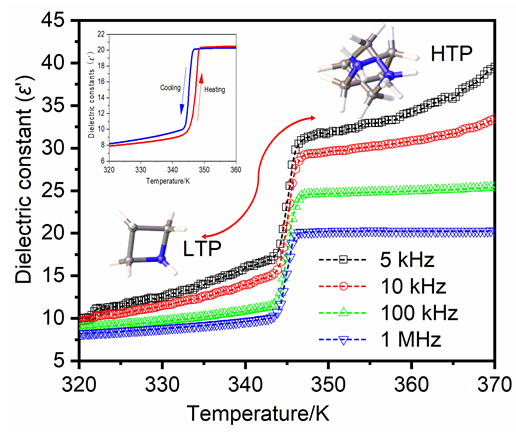| [1] |
Kang, S.; Jillella, R.; Park, S.; Park, S.; Kim, J. H.; Oh, D.; Kim, J.; Park, J. Nanomaterials 2022, 12, 3806.
doi: 10.3390/nano12213806
|
| [2] |
Jia, Q. Q.; Ni, H. F.; Lun, M. M.; Xie, L. Y.; Lu, H. F.; Fu, D. W.; Guo, Q. J. Mater. Chem. C 2022, 10, 16330.
doi: 10.1039/D2TC03497B
|
| [3] |
Bai, T. X.; Wang, X. C.; Wang, Z. Y.; Ji, S. J.; Meng, X.; Wang, Q. J.; Zhang, R. L.; Han, P. G.; Han, K. L.; Chen, J. S.; Liu, F.; Yang, B. Angew. Chem. Int. Ed. 2023, 62, e202213240.
|
| [4] |
Liu, S.; He, L.; Wang, Y.; Shi, P.; Ye, Q. Chinese Chem. Lett. 2022, 33, 1032.
doi: 10.1016/j.cclet.2021.07.039
|
| [5] |
Fukuta, Y.; Miyata, T.; Hamanaka, Y. J. Mater. Chem. C 2023, 11, 910.
doi: 10.1039/D2TC04395E
|
| [6] |
Tian, Y.; Peng, H.; Wei, Q. L.; Chen, Y. X.; Xia, J. J.; Lin, W. C.; Peng, C. Y.; He, X. F.; Zou, B. S. Chem. Eng. J. 2023, 458, 141436.
doi: 10.1016/j.cej.2023.141436
|
| [7] |
Liu, H.-Y.; Zhang, H.-Y.; Chen, X.-G.; Xiong, R.-G. J. Am. Chem. Soc. 2020, 142, 15205.
doi: 10.1021/jacs.0c07055
|
| [8] |
Wang, C. C.; Yan, R. Y.; Cai, M. J.; Liu, Y. P.; Li, S. J. Appl. Surf. Sci. 2023, 610, 155346.
doi: 10.1016/j.apsusc.2022.155346
|
| [9] |
Guo, Z.-Y.; Zhou, H.-P. Acta Chim. Sinica 2021, 79, 223. (in Chinese)
doi: 10.6023/A20100463
|
|
(郭镇域, 周欢萍, 化学学报, 2021, 79, 223.)
doi: 10.6023/A20100463
|
| [10] |
Xu, H.-J.; Han, S.-G.; Sun, Z.-H.; Luo, J.-H. Acta Chim. Sinica 2021, 79, 23. (in Chinese)
doi: 10.6023/A20080375
|
|
徐豪杰, 韩世国, 孙志华, 罗军华, 化学学报, 2021, 79, 23.)
|
| [11] |
Xu, W.-J.; He, C.-T.; Ji, C.-M.; Chen, S.-L.; Huang, R.-K.; Lin, R.-B.; Xue, W.; Luo, J.-H.; Zhang, W.-X.; Chen, X.-M. Adv. Mater. 2016, 28, 5886.
doi: 10.1002/adma.201600895
|
| [12] |
Han, S.; Zhang, J.; Sun, Z.; Ji, C.; Zhang, W.; Wang, Y.; Tao, K.; Teng, B.; Luo, J. Inorg. Chem. 2017, 56, 13078.
doi: 10.1021/acs.inorgchem.7b01863
|
| [13] |
Wu, Y. L.; Lu, S. H.; Zhou, Q. H.; Ju, M. G.; Zeng, X. C.; Wang, J. L. Adv. Funct. Mater. 2022, 32, 4579.
|
| [14] |
Wu, L. K.; Feng, Y.; Wang, Z. J.; Li, L. H.; Hu, Z. B.; Ye, H. Y.; Li, J. R. Inorg. Chem. Commun. 2022, 142, 109641.
doi: 10.1016/j.inoche.2022.109641
|
| [15] |
Wu, F. F.; Wei, Q. Y.; Li, X. Q.; Liu, Y.; Huang, W. Q.; Chen, Q.; Li, B. X.; Luo, J. H.; Liu, X. T. Cryst. Growth Des. 2022, 22, 3875.
doi: 10.1021/acs.cgd.2c00257
|
| [16] |
Rok, M.; Zarychta, B.; Janicki, R.; Witwicki, M.; Bienko, A.; Bator, G. Inorg. Chem. 2022, 61, 5626.
doi: 10.1021/acs.inorgchem.2c00363
|
| [17] |
RaeisianAsl, M.; Panahi, S. F. K. S.; Jamaati, M.; Tafreshi, S. S. Int. J. Energ. Res. 2022, 46, 13117.
doi: 10.1002/er.v46.10
|
| [18] |
Liu, Y. H.; Wang, W. Q.; Zhang, B. L.; Wang, Y. J.; Ren, M. P.; Jing, Z. H.; Yue, C. Y. CrystEngComm 2023, 25, 444.
doi: 10.1039/D2CE01342H
|
| [19] |
Hua, X.-N.; Huang, C.-R.; Gao, J.-X.; Lu, Y.; Chen, X.-G.; Liao, W.-Q. Dalton T. 2018, 47, 6218.
doi: 10.1039/C8DT00786A
|
| [20] |
Liu, J. Y.; Ye, S. Y.; Wan, M.; Wang, Y. N.; Tong, L.; Chen, L. Z. New J. Chem. 2022, 46, 1054..
doi: 10.1039/D1NJ05074E
|
| [21] |
Rao, W.; Li, M.; You, X.; Wei, Z.; Zhang, M.; Wang, L.; Cai, H. Inorg. Chem. 2021, 60, 14706.
doi: 10.1021/acs.inorgchem.1c01816
|
| [22] |
Hua, X.-N.; Gao, J.-X.; Chen, X.-G.; Li, P.-F.; Mei, G.-Q.; Liao, W.-Q. Dalton T. 2019, 48, 6621.
doi: 10.1039/C9DT00945K
|
| [23] |
Jayatilaka, D.; Wolff, S. K.; Grimwood, D. J.; McKinnon, J. J.; Spackman, M. A. Acta Cryst. 2006, 62, 1107.
|
| [24] |
Dolomanov, O. V.; Bourhis, L. J.; Gildea, R. J.; Howard, J. A. K.; Puschmann, H. J. Appl. Cryst. 2009, 42, 339.
doi: 10.1107/S0021889808042726
|
| [25] |
Sheldrick, G. M. Acta Cryst. 2015, A71, 3.
|
 ), 花秀妮b,*(
), 花秀妮b,*( )
)
 ), Xiuni Huab(
), Xiuni Huab( )
)
